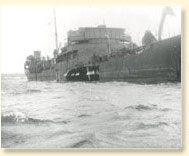

Torpedo damage to Dutch tanker S.S. Corilla, Halifax, N.S., February 1942
Photo : Royal Canadian Navy |
The Battle of the Atlantic
The Battle of the Atlantic was the struggle between the
and
powers
for control of the sea routes
between the Americas and Europe and Africa. It began on
the first day of the war in Europe in September 1939 and
continued until May 1945. It was the longest campaign of
the Second World War, an extremely bloody one, and the
single battle on which the whole outcome of the war
depended. Only with delivery of massive North American
resources to Britain and Europe could the
defeat
Hitler's Germany, the most powerful of the nations.
Britain always depended upon ship-carried imports of
oil, food, and industrial products from the Americas, and
especially the United States and Canada. ( see Agriculture ) German naval
and maritime air forces, later with help from Italy,
attempted to break this vital supply line. Britain's large
fleet of surface warships defeated Germany's powerful, but
not numerous, surface warships. Allied defences against
submarines, by contrast, were not well developed. Britain
sailed merchant ships in groups ("convoys") between
Britain and Canada's east coast ports under the protection
of anti-submarine warships. Germany's rapidly expanding
""
fleet, however, was able to overwhelm the small
number of anti-submarine warships available in the first
years of the war. Canada assisted greatly by expanding its
own navy with large numbers of Canadian-built anti-submarine warships
( see Shipping and
Shipbuilding ), and also expanding its air force with
long-range anti-submarine aircraft. With this help, and
with further assistance from the United States, in May 1943
Britain was able to concentrate its most powerful anti-submarine warships
and aircraft to force the Germans away
from the principal convoys. This turning point was crucial.
It allowed the buildup of US and Canadian supplies, armies
and air forces in Britain for the liberation of Europe.
Nevertheless, ,
with new equipment, were able to
evade and inflict shipping losses right until
the defeat of Germany in May 1945.
During the six years of the Battle of the Atlantic, the
powers lost over 700
and 32,000 seamen, and
the lost more than 3,000 ships, and 40,000
seamen. The vast majority of the
losses were
merchant ships and the civilian seamen and passengers who
sailed in them.
Related Newspaper Articles
English Articles
French Articles
-
Comment nous défendons notre commerce maritime
Le Devoir, 03/01/1940
-
Navire canadien coulé en haute mer
Le Devoir, 06/09/1940
-
Les rescapés de l'Atlantique
Le Devoir, 27/09/1940
-
Croiseur ennemi en Atlantique
Le Devoir, 06/11/1940
-
"Le sous-marin, principale menace pour la Grande-Bretagne"
Le Devoir, 09/11/1940
-
La question des transports océaniques ennuie Londres
Le Devoir, 14/01/1941
-
Les Allemands font des leurs en Atlantique-nord
Le Devoir, 17/01/1941
-
La bataille de l'Atlantique éclipse toutes les autres
Le Devoir, 16/04/1941
-
Tragédie maritime pour le Canada
Le Devoir, 06/05/1941
-
"Des sous-marins allemands opèrent en vue de Terre-Neuve, déclare le ministre canadien de la marine"
Le Devoir, 05/11/1941
-
Ottawa délimite onze régions 'vulnérables'
Le Devoir, 04/11/1941
-
L'Allemagne a lancer une grande offensive sous-marine dans le nord de l'Atlantique
Le Devoir, 20/02/1942
-
Premier torpillage dans le golfe Saint-Laurent
Le Devoir, 13/05/1942
-
Les torpilles dans les Saint-Laurent
Le Devoir, 14/07/1942
-
"Énorme pertes de navires marchands, depuis trois ans"
Le Devoir, 01/09/1942
-
La guerre sous-marine prend de plus en plus d'ampleur
Le Devoir, 21/01/1943
-
Fermeture du Golf St-Laurent à la navigation l'été prochain
Le Devoir, 25/02/1943
-
La protection des convois entre l'Angleterre et le nord-ouest de l'Atlantique
Le Devoir, 01/05/1943
-
Belle victoire d'un équipage du C.A.R.C.
Le Devoir, 17/08/1944
-
Une frégate canadienne coule un sous-marin
Le Devoir, 04/04/1945
|